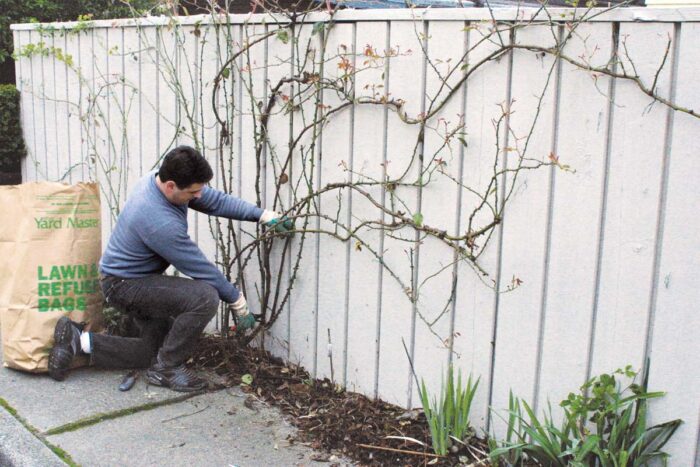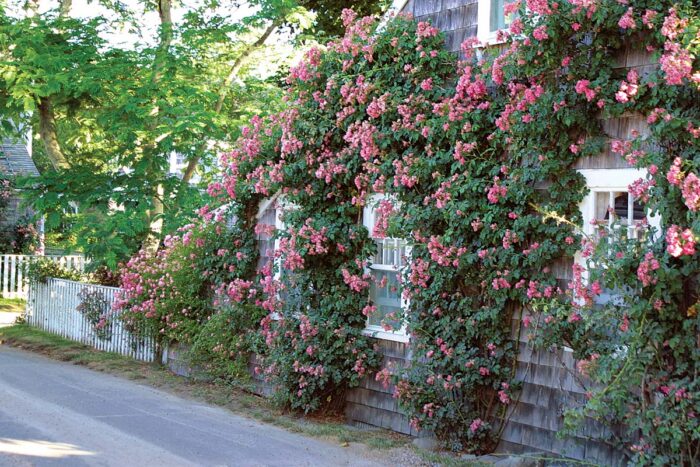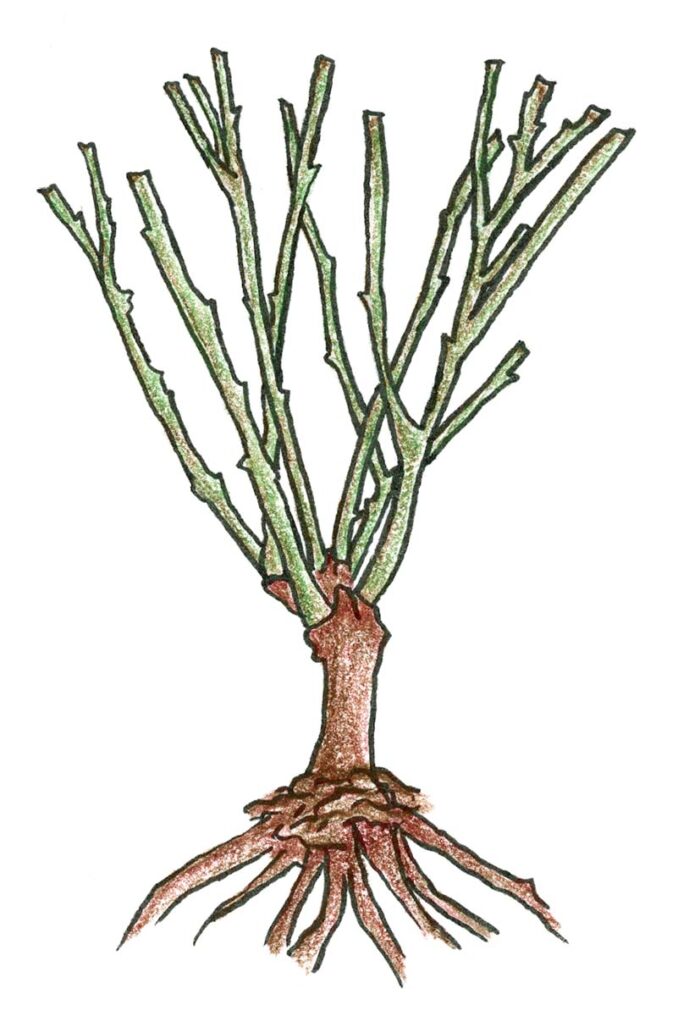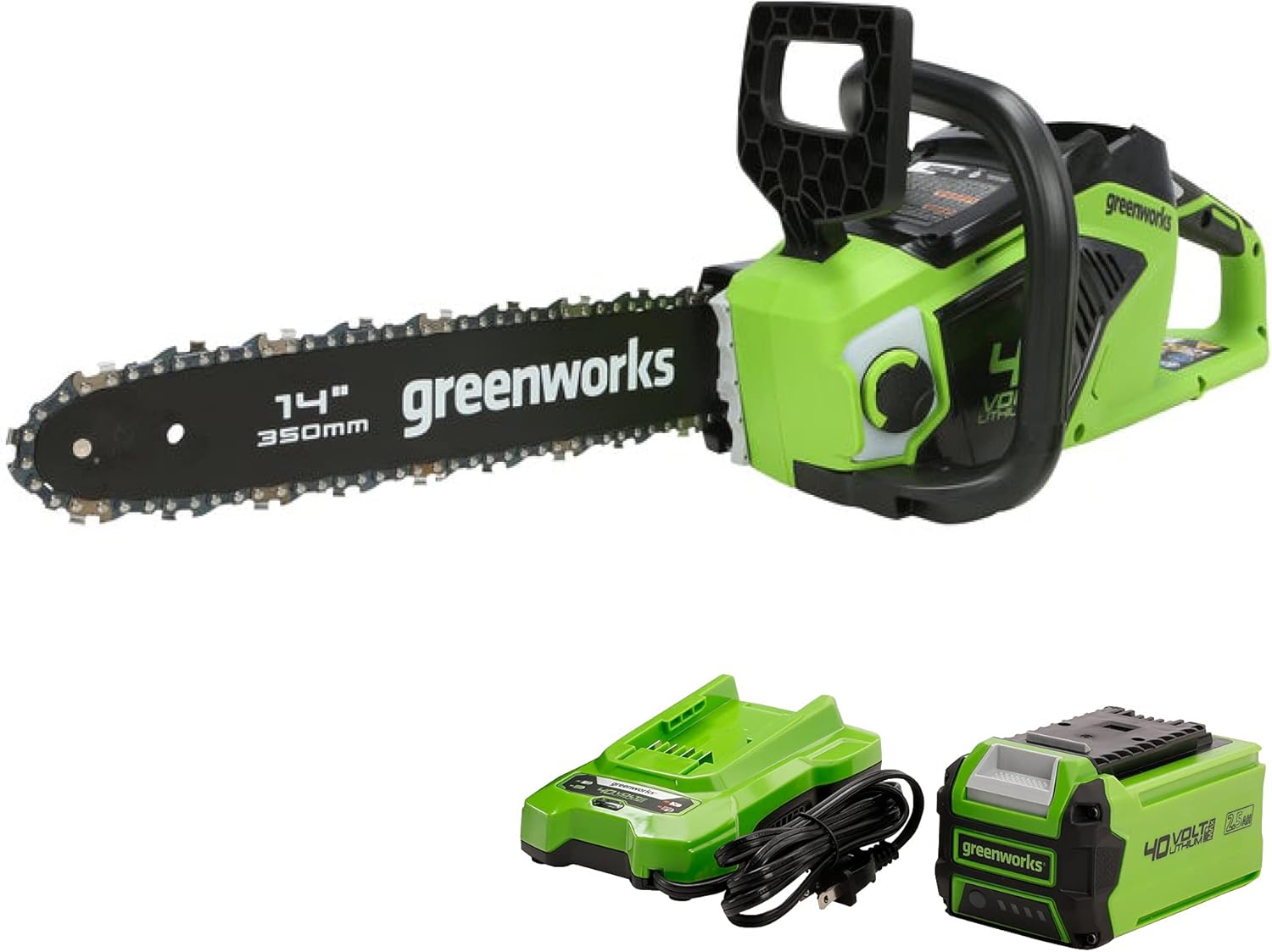Two Steps for Pruning Climbing Roses
Prune yearly for healthier, more manageable growth and bigger, better flowers

It’s best not to procrastinate when it comes to pruning climbing roses. Whether climbing roses are grown on a wall, fence, trellis, post, or pillar, I recommend pruning them every year not only to keep your climbers from overwhelming their supports but also to spare you the frustration of dealing with an overgrown snare of canes. Your roses will reward you with robust growth and more flowers.
Diseased branches are the first to go
Most climbing roses bloom at least twice each growing season: first on older branches and then on the current season’s growth. Pruning them while dormant in mid to late winter will encourage plenty of late-season flowers. I like to begin my pruning by removing as much foliage as possible from each rose. This helps prevent disease by removing dormant fungal spores and allows me to see the rose’s branching structure as I prune. Once I can see what I’m dealing with, I remove any diseased, injured, or spindly branches, cutting them away flush with the cane from which they emerge. If any of the older, woody canes have failed to bloom well during the previous season, I will prune them off too. Any canes that have outgrown their support will get a preliminary trim to set them back inbounds. I will also remove any crossing or awkwardly placed branches.

Prevent the spread of disease
Disinfect your pruning shears before moving on to the next plant by dipping them into a 25 percent bleach solution, rubbing them with an antiseptic wipe, or spraying them with a commercial disinfectant.
Step back before moving on
After pruning undesirable branches, I’ll step back, have a look at what remains, and choose the branches that will form the plant’s main framework for the upcoming season. I look for strong, healthy canes with plenty of swelling buds or side shoots (called laterals). I’ll need enough vigorous canes at various heights to cover the support from top to bottom without crossing. Any branches that don’t meet my criteria are removed.
I prefer to prune and train the lowest of the chosen canes first. I unfasten each branch one by one and trim it to fit the support, making sure I cut far enough back to account for new growth. I then shorten each of the lateral shoots down to two to five buds, always cutting about ¼ inch above, and parallel to, a bud. I then reattach the main branch to the support, keeping it as close to horizontal as I can. Since climbing roses have no tendrils, rootlets, or twining stems to help them cling to their support, they need our help to stay in place. I prefer plastic ties that stretch as the canes grow, but plastic-coated wire ties are fine, too, as long as they are tied loosely, with plenty of room for the branch to expand. If any branch still projects beyond the support once it’s attached, I’ll finish by trimming away the excess.
Don’t forget to take a few steps back after pruning and training each main branch. Otherwise, you may get so involved in cutting and placing the branch you’re working on that you lose sight of the plant’s overall shape. Remember that the end goal is a climbing rose that decorates its support without overwhelming it.
Part 1: Prune out old and undesirable branches
 |
 |
| Old canes become less productive and produce fewer and smaller blooms. | Crossing branches should be removed. If you have to make a choice, keep the younger, more vigorous branch. |
Part 2: Trim what’s left with a framework in mind
Types of frameworks for roses
The objective in pruning climbers is to clothe their supports in a framework of healthy, vigorous growth, which will produce a large quantity of quality blooms in the upcoming season.
TIP: Don’t forget to remove suckers from a grafted rose

If I’m pruning a bud-grafted rose, I’ll check the base of the plant for any suckers growing from the rootstock below the bud union—a knobby, swollen mass at or near the soil surface. Pruning rootstock suckers yields temporary results, so I remove them by yanking sharply downward near the point where they emerge from the plant. This removes all of the bud tissue from which the sucker grew. If these suckers are allowed to persist, they will eventually overwhelm the upper, grafted portion of the plant.
Video
How to Prune Climbing Roses
More videos on pruning roses
How to Prune Shrub Roses
Fine Gardening Recommended Products

Greenworks 40V 14" Chainsaw, 2.5Ah USB Battery and Charger Included
Fine Gardening receives a commission for items purchased through links on this site, including Amazon Associates and other affiliate advertising programs.

SHOWA Atlas 370B Nitrile Palm Coating Gloves, Black, Medium (Pack of 12 Pairs)
Fine Gardening receives a commission for items purchased through links on this site, including Amazon Associates and other affiliate advertising programs.












Comments
Deadheading climbing roses will mean I'll loose my winter hips, so deadhead or not?
deadhead
Horticulture and gardening needs to trim for certain plants those need to be pruning.This site https://www.customwriting.com/ helps to write paper on different range of topic and you may take content for describing your methods for pruning climbing rose.
Designing a garden for home is not a child's play a person has to do a lot of things so as to maintain the beauty of the garden health as well. Source https://luckypennsylvania.com is amazing in casino playing. I noted down your tips in this regard.
This is very helpful, thank you for the tips you've shared :) mathgoodies.com/
Prune out the old one should be done. Otherwise, it will ruin the roots. It's just like I prune out errors from the icons as an icon designer at logo designer agency that is necessary for web growth.
Log in or create an account to post a comment.
Sign up Log in